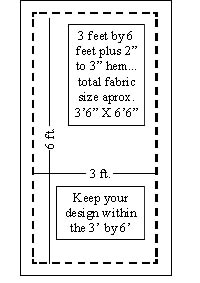Let us help you
Creating a panel for a loved one lost to AIDS can provide a healing experience while creating a personal memorial. Panelmakers will be at the Workshops to provide technical assistance and support to people wishing to make a panel for The Quilt. You can bring materials to work on your panel or just come for ideas.
The Detroit Institute of Arts sponsors Panelmaking Workshops on the third Sunday of each month at 1:00 p.m. Enter at the Farnsworth Entrance and see the Information Desk for the location of the Studio.
For organizations that would like to consider a special workshop at their location please contact us. We will do our best to accomodate your needs.
Panel Done?
Click HERE to link over to our webpage with instructions on what to do next.
 ll kinds of people have made panels for The Names Project AIDS Memorial Quilt, in a variety of colors, fabrics, and styles. You do not have to be a professional artist or a sewing expert to create a moving personal tribute. It doesn't matter if you use paint or fine needle work; any remembrance is appropriate. You may choose to create a panel privately as a personal memorial to someone you've loved, but we encourage you to follow the traditions of old-fashioned sewing and quilting bees, by including friends, family, and co-workers.
ll kinds of people have made panels for The Names Project AIDS Memorial Quilt, in a variety of colors, fabrics, and styles. You do not have to be a professional artist or a sewing expert to create a moving personal tribute. It doesn't matter if you use paint or fine needle work; any remembrance is appropriate. You may choose to create a panel privately as a personal memorial to someone you've loved, but we encourage you to follow the traditions of old-fashioned sewing and quilting bees, by including friends, family, and co-workers.
Steps for Designing a Panel:
Include the name of the friend or loved one you are remembering. Feel free to include additional information such as the dates of birth and death, and a hometown. Please limit each panel to one individual.
Choose your materials:
Remember that the Quilt is folded and unfolded many times, so durability is crucial. A medium-weight, non-stretch fabric such as a cotton duck or poplin works best. Your design can be vertical or horizontal, but the finished, hemmed panel must be 3 feet by 6 feet (90 cm X 180 cm) - no more and no less! When you cut the fabric, leave an extra 2-3 inches on each side for a hem. If you can't hem it yourself, we'll do it for you. Batting for the panels is not necessary, but backing is recommended. Backing helps to keep panels clean when they are laid out on the ground. It also helps retain the shape of the fabric.
Suggested Techniques:
Appliqué: Sew fabric letters and small mementos onto the background fabric. Do not rely on glue. It won't last.
Paint: Brush on textile paint or color-fast dye, or use an indelible ink pen. No "puffy" paint; it's too sticky.
Stencil: Trace your design on to the fabric with a pencil, lift the stencil, then use a brush to apply textile paint or indelible markers.
Collage: Make sure that whatever materials you add to the panel won't tear the fabric (avoid glass and sequins for this reason), and be sure to avoid very bulky objects.
Photos: The best way to include photos or letters is to photocopy them onto iron-on transfers, iron them onto 100% cotton fabric and sew that fabric to the panel. Many retail copy shops can also transfer images onto fabric which you can then sew directly to your panel.
SIZE MATTERS:
We can not stress enough the importance of designing your Panel within the very specific parameters required of the Quilt. Your panel should be 3'6" X 6'6" in total leaving a 3" hem on all three sizes. The diagram below demonstrates this with the Panel (3'6" X 6'6") being the sold line box and the interior dotted line representing your actual work space of the 3' X 6' panel. TIP: due to sewing needs after panels are turned in it is best to not have your design go all the way to the edge of your work area...try to leave at least an inch from the 'dotted line.'



